U-M’s 14th president will lead the University into its third century
As Mark S. Schlissel, MD/PhD, settles into his new role this month, he is aware that everyone wants to ask what he’s going to do as president. But Schlissel says he has a lot of listening and learning to do, and he’s “not a top-down kind of guy.” The best ideas, he says, come from faculty, students, and staff.
“One of my most important contributions as president is to recognize good ideas, to play air traffic controller, to look for synergies across the breadth of this outstanding academic community, and to get the right people in the room together,” he says. “We need to seize opportunities, to find the match between what Michigan is good at, and what our society needs.”
After being selected in January by the Board of Regents to succeed Mary Sue Coleman, Schlissel started his tenure July 14. The 56-year-old biomedical researcher comes to Michigan from Brown University where he had been provost since 2011. Before that he was dean of biological sciences in the College of Letters & Science at the University of California, Berkeley, where he also held the C.H. Li Chair in Biochemistry.
Schlissel arrived on campus following a vacation tour of Michigan with his wife, Monica Schwebs.
The University Record met with Schlissel in June to discuss a wide range of topics. Here is that conversation, reprinted courtesy of the Record.
It’s been nearly six months since you were named president. Can you share with us some of the ways in which you have been learning about U-M?
I’ve been back in Ann Arbor six or seven times since January for meetings with executive officers, regents, many deans, and groups of faculty. I’ve met the head of the U-M Alumni Association, the head of campus security, and our chief investment officer who invests our wonderful endowment, among many others.
I’ve been introducing myself and learning about them, learning about their portfolios. I asked each of them what their challenges are, what they think our greatest opportunities are, what I can do as president to help them do their jobs better, to make the University stronger.I’ve met with six or eight student groups. I have given interviews to the student newspaper, to other local venues. Interestingly as well, I’ve met a lot of Michigan alumni who are Brown faculty who had been at Michigan at one time or another. It’s clear that anyone who has touched the place is passionate about U-M and they immediately light up and tell me their Michigan stories.
Anything you’ve learned from those interactions? Or even particularly from students or alumni?
What I noticed immediately was the passion that people have for this place and their connectedness to it. And I’ll tell you, one of the things I was incredibly impressed with occurred during the Being Black at Michigan Twitter campaign (#BBUM) and the discussions that followed. When that group of students came to the regents’ meeting, and sat in the front row with duct tape covering their mouths, and the duct tape said GO BLUE — that really said a tremendous amount to me. It said that even students who have issues they’re not happy with, and students who fear their voices aren’t being heard, both show their cleverness — by using duct tape — but also their love for the place. I never got a sense that any of the discontent was destructive. It was constructive discontent. I was really proud and impressed.
The other thing I’ve seen is that the campus is in spectacular shape for a public institution that has been through a challenging decade. And that’s compared to my experiences at other universities where the first thing that goes, in a time of crisis, is maintenance. You stop building and things just aren’t as well cared for as the administration circles the wagons. Through Mary Sue’s leadership, working with the regents and generous donors, the University continues to have the kind of wonderful physical spaces it takes to make a learning community. And I am pleasantly surprised every time I’m on the campus that Michigan did not give up on the idea that space matters.
As you begin to learn about U-M, do you see areas that you want to emphasize during your presidency?
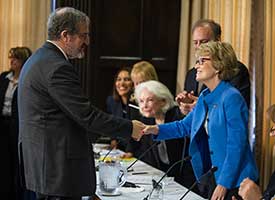
President Emerita Mary Sue Coleman welcomes President Schlissel to U-M. (Photo: Scott C. Soderberg, Michigan Photography.)
It’s really too early to say. I have a lot to learn. Certainly I want to promote the academic strength of the institution. I want to make the campus a diverse, inclusive, welcoming place for students, staff, and faculty. Every individual has a central place in the community. Ultimately there will be areas of scholarship and areas of education that I will want to promote. But personally, I’m not a top-down kind of guy. The best ideas come from faculty, students, and staff. One of my most important contributions as president is to recognize good ideas, to play air traffic controller, to look for synergies across the breadth of this outstanding academic community, and to get the right people in the room together. We need to seize opportunities, to find the match between what Michigan is good at and what our society needs. I’m going to spend a significant fraction of time my first academic year learning enough about our strengths and our opportunities to make good decisions in consultation with the rest of the community.
We should be tapping into our comprehensive excellence to do things others cannot. I am hoping we will find a way to focus more on the campus climate for students, how to engage in civil discourse, finding ways to improve inclusiveness, and increase diversity. Also, I’d like to keep looking for ways in which U-M can do more to help Detroit and the state economy.
Michigan has many very strong programs, but there always is room for improvement. I’ll need to work closely with the provost and other leaders across the schools and colleges to figure out where my focus might make the biggest difference. I’ll want to be sure that all of our schools and colleges have thoughtful strategies for how to improve and increase their value to our students and to our state. I want to reinforce the highest standards in faculty hiring and promotion, and I want us to work hard to further diversify the faculty. Ultimately, we’ll need to continue to enhance our academic infrastructure and invest in programs that make Michigan a place where faculty and students feel they can do their best work.Academic quality is something you’ve mentioned a number of times. What are some of the opportunities for improvement?
What would you like the faculty and staff to know about your approach to being
U-M’s 14th president? How do you plan to interact with faculty and staff?
I realize that I need to spend time learning about U-M and listening to faculty, students, and staff regarding what they care about.
My job is to recognize and invest in excellence and promote both synergy and balance across the campus. I do intend to attend faculty meetings, visit schools and departments, host fireside chats with students, drop by student events, attend staff group forums, and host events at our home.
What do you see as the role for faculty leadership/governance in your areas of focus?
The faculty is the centerpiece of the academic community. There is a concept in academia that I strongly adhere to and that is faculty governance or self-governance. To me what that means is that issues of academic standards, academic integrity, the criteria for hiring, promoting, tenuring — these are all responsibilities of the faculty. I think that faculty organizations work together to define what excellence looks like in each of our schools and colleges; that’s very much their responsibility. You can’t be a great university without a faculty that is spectacular, and not only spectacular, but a faculty that cares about the success of the institution as a whole, not just the success of their own department.
I want to engage with the faculty as a faculty colleague as well as the president.

President Schlissel chats with Gov. Rick Snyder, BGS ’77/MBA ’79/JD ’82. The governor stopped by the Fleming Building to welcome Schlissel on his first day as U-M’s 14th president. (Photo: Scott C. Soderberg, Michigan Photography.)
I was extremely proud to have appointments in both the Medical School and in the Department of Molecular, Cellular, and Developmental Biology within LSA. When I finish being president I look forward to being a part of the Michigan faculty and teaching, and perhaps even starting a lab again.
And, of course, whenever significant decisions are to be made that affect the academic future of the University, these decisions will critically involve the input of faculty at all different levels. There are many faculty members who end up rising into the leadership positions on the campus and they have a very direct connection with their colleagues, so the department chairs and deans, many of them have been regular faculty members and have a great sense of the institution, and I’ll get to know them and rely on them. I want to try my first year to attend at least one faculty meeting in each of the schools and colleges. Just to sit and listen, to learn, to answer questions, to tell people my very early thoughts, and I think that will be a great way to meet faculty.
I want to host social events at the house for different groups of faculty. Even at Brown where there are only 730 regular campus faculty members, I would bring people together who had been there for a decade and never really met. And it’s great fun because these are really smart, lively, engaging people who represent very different disciplinary traditions and fun things happen when you put them around a dinner table together.
You have some major executive positions you need to fill. Can you talk about what you are looking for in filling those leadership roles?
It’s really a combination of things that I will be looking for in candidates to fill these leadership positions. It’s things like technical competence and experience, passion for the mission, absolute integrity. These positions are among the most attractive leadership jobs in all of academia. We should be able to hire outstanding executive officers. And we will always be looking for ways to diversify the backgrounds of leadership to enhance group decision-making.
For the next executive vice president for medical affairs, we’ll be seeking an academic doctor with research and clinical leadership experience. We’ll need someone with a good sense of trends in health care, good business sense, a commitment to quality care, and a real sensitivity to what faculty and students need to be successful.
The chief financial officer position could be filled by someone from either inside or outside of academia. Business and management acumen will be critical, along with an ability to explain challenges and opportunities to constituencies. It’s essential that we find someone who can work collaboratively and has a passion for higher education.
What types of interaction do you expect to have with the campus communities in Flint and Dearborn?
In many ways, it’s one of my larger challenges because I don’t have any experience base of having worked at a regionally focused university campus. So I need to get to know the leadership of those campuses. We have a new chancellor coming in for Flint, we have a very experienced chancellor at Dearborn, and I need to rely on them to help me learn about their communities. The Flint and Dearborn campuses are transforming lives and changing economies, and that’s a critical part of our mission. I’ll ask them the same questions I’ve been asking people on the Ann Arbor campus: What can I do to make their enterprise better?
What would you want students to know about you and your approach to serving as
U-M president?
I would want them to know that I believe my most important responsibility is to assure that every one of them gets a world-class education and gets to take advantage of all our community has to offer. I want to help nurture students and provide them with opportunities to thrive. I want to celebrate their successes, but also look for moments where we can all learn from one another. I feel personally responsible for the quality of their education and the support of their non-curricular needs.
College affordability will certainly continue to be an issue of great concern for U-M students, parents, and the public. What have you learned about the institution’s affordability efforts?
It is undoubtedly one of the most challenging issues we must confront — and across the board, not just Michigan, not just publics, but also privates. We’re in a very expensive business, and it’s a very human-intensive business. We teach students by personally interacting with them and engaging in discussion, so there are not tremendous efficiency gains to be had as there are in other industries.
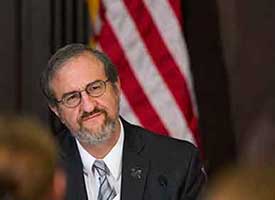
President Schlissel says he is “not a top-down kind of guy.” (Photo: Scott C. Soderberg, Michigan Photography.)
In academia, it’s expensive. We’ve got a campus with an enormous physical plant that requires fixed costs to maintain. And we operate in a very competitive landscape. Michigan should be as good as the very best universities in the world, and we have to compete to achieve that level. So there are tons of upward cost drivers. The challenge for us is to be as efficient and effective as possible with our resources so that we can constrain the increase in tuition, and then use as many resources as we can set aside for financial aid to maintain the accessibility and the affordability of the institution. And so far there’s been a formula that works, but it’s an everyday challenge.
I think it’s wonderful that the (Victors for Michigan) campaign has a $1 billion goal for student support, which is an inspiring number. And also this year’s budget includes a very significant increase in financial aid, partially due to an increase in state funding.
I’m very hopeful because the state is starting to reinvest in higher education. It’s nowhere near making up for the dramatic cuts and lost purchasing power of the last decade, but the trend is very heartening. And the leadership of the state seems to get it. They seem to get the impact, the strong positives that higher education brings to Michigan. I think there are some interesting ideas exploring new ways of linking cost to family or future income. Also, I think we need to come to terms with the idea that a modest amount of student debt is an important investment of a student in his or her own future.
Increasing racial, ethnic, and socio-economic diversity among students has been a topic of much discussion recently. What have you learned about U-M’s efforts in this area?
I think it’s a complex and multilayered issue. I think the University’s heart is in the right place, but it’s been very challenging. Let’s be honest: We’ve lost ground but we must not waiver in our ongoing battle to diversify the campus. I think it’s important when you think about diversity, not to only think about race and ethnicity, but we’re talking about economic diversity, political diversity, experiential diversity as well. We must be creative and redouble our efforts.
The diverse voices that are around the table as students learn from one another make a large contribution to academic excellence. So it’s more than just an issue of fairness and an issue of being a public institution that should look like the state it’s serving. We can’t be excellent without being diverse.We’re constrained in the types of things we can do, of course, but I don’t think it’s an unreasonable goal for the University of Michigan to aspire to have every talented high school student in the state of Michigan apply to their flagship university. I want every single one to apply, and then I want our highly professional and insightful admissions office to look hard to identify talented kids who can thrive here, and then I want to recruit every single one of them.
And so it’s a math thing: You get the largest pool of applicants that you can, and that means lots of outreach into places we haven’t gone to often enough, haven’t gone effectively. Recruiting is very important and I want to partner with the students on campus who are holding our feet to the fire about diversity to help us become more diverse by helping us recruit. Two key aspects of successful recruiting are a campus climate that is welcoming and sufficient financial aid to lower barriers to access. We simply must create and maintain an environment where all students can reach their full potential.

“I want to make the campus a diverse, inclusive, welcoming place for students, staff, and faculty,” says President Schlissel. (Photo: Scott C. Soderberg, Michigan Photography.)
We talk about diversity and we measure numbers. I think to be really diverse, we have to be able to tap into campus diversity for the purpose of learning and the purpose of excellence. That means having an environment where everybody feels equally included, people feel as though their voices are heard, just like other people’s voices are heard, that they’re welcomed at any type of event by any type of group, that there’s a comfort level on campus where people can engage across differences, where they can discuss topics that either political correctness or other social taboos try to stamp out.
One of the other topics I want us to focus on is civil discourse. I want to help us teach one another how to discuss difficult issues and how to model that behavior for society more broadly. Think about how wonderful it would be if Michigan became well known as a place where you could have hard discussions with mutual respect. People may not change their minds, but the level of understanding and our ability to live together will truly grow.
Student sexual misconduct is getting national attention and U-M faces a federal review of its policies and procedures. What do you know about U-M’s approach?
I’ve seen Michigan’s policies on sexual misconduct, and we have good policies and procedures that are in compliance with the most recent guidance from the Department of Education. What we have to do now is make certain that everyone understands those policies; that they’re applied rigorously, carefully, and methodically. And, perhaps most importantly, we have to approach this with sensitivity to victims, but also a sense of fairness to both accuser and accused.
I think the other thing the University has to do, and it’s doing already, is to educate students, to help individuals understand how to interact with one another with mutual respect and what their limits are, to discuss the nature of what consent means, and to make sure everybody understands the standards they are going to be held to in their personal behavior.
And we have to deal with the alcohol culture on college campuses. Most episodes of sexual misconduct among students involve one or another party who has been drinking.
Have you thought about how you want to engage students as president?
One of the most fun and energizing things for me is to be on campus. I spent so many years on campus as a student myself that my family teased me about it, but now I tell them I’ve never left.
Whenever I’ve been on campus (as president-elect) there has been a buzz and people are busy. I am eager to engage with student groups. I want to engage with student government. I’ll have regular meetings with The Michigan Daily.

The President’s House is undergoing renovation. Get a peek inside. (Photo: Austin Thomason, Michigan Photography.)
I wrote for the Daily Princetonian when I was an undergraduate and I had a wonderful time doing it. At Brown as well as here at Michigan, I have enjoyed meeting with student journalists. One of my visits here I met with the leaders of a bunch of different student clubs and they all invited me to their events, and I’ll attend a number of student events through the year.
I want to use the President’s House as a venue to get to know students. I’d like to involve students in all the hosting I do of outside visitors. So if I have a dinner at the house for an interesting outside speaker, or a visitor to campus, I’d love to have a student or two as part of the group and not just faculty, for example. That would be fun. I’ll continue to seek out ways to engage with students.
Do you think you will continue the tradition of welcoming students to the President’s House?
It’s challenging, but I love the idea of living in the heart of the campus. This President’s House is as much a part of the campus as I’ve ever seen. Fortunately, Mary Sue tells me students are respectful of the fact that I actually live there and don’t camp out on the lawn, etc. I hear they come for trick-or-treating.
I have four kids, and they’re all grown and out of the house; my youngest will be a senior in college next year. They were some of the most wonderful years of my life because when the kids were around I felt like I was helping nurture them. It may sound corny, but helping lead a college campus and living in the midst of that campus replaces a little bit about what I miss of not having kids in the house anymore. Just this feeling that I could be partially responsible for the nurturing of young people during very important stages in their lives.As a physician-scientist, you bring a unique perspective to the role of president of a university with a world-class health system. What are your thoughts about the U-M Health System?
One of the most attractive parts of my coming here is this wonderful academic medical center. Michigan has a great medical school, it owns its own hospital, its own faculty practice plan, its own clinics. It has under its own unified control the ability to go from basic laboratory discovery to patient care and treatment. Many institutions envy that alignment.
There are huge challenges that come from health-care reform nationally, from a health-care delivery model that’s broken and that we can no longer afford. In fact, we haven’t been able to afford it for a long time and we’re just realizing it now. So our medical center is going to have to adjust, as every other medical center is, to new modes of reimbursement and ways of organizing patient care. But we’ve got all the tools and alignment necessary to do that. It will be challenging, but we don’t have organizational barriers in our way as well.One of my ambitions is to have the academic medical center think of itself, and to have the campus think of the academic medical center, more as part of a whole. So as large as it is, as much autonomy as we give it, there are many academic departments in other parts of the campus that would have wonderful synergies with the medical center. The campus has a big biology program, but also there’s physics and chemistry and math. There’s engineering, there’s law, there’s public policy, there’s public health.
With all of these components, we can be a seamless, integrated, knowledge-generating machine for the life and health sciences. That’s one of my aspirations for the University, not just to enhance the vigor of the medical school, but to integrate it as fully as possible with the scholarship that goes on around the rest of the campus.
What about getting to know U-M athletics?
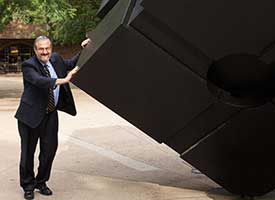
Legend has it that the U-M president must spin the Cube each morning to activate the University. (Photo: Michigan Photography.)
Athletics is a wonderful community-building thing for the campus and we just have to be careful that the balance remains appropriate given that we are a great academic institution. We’re very fortunate, among a handful of schools, where I’m not coming in worrying about how I’m going to prop up the athletics program.
U-M athletics is one of the major things that links alumni to the University across generations. It actually does a tremendous amount for building community and a sense of sharing across the campus. So there are huge numbers of positives, and then there are these extrinsic challenges that come from competitive intercollegiate athletics becoming enormously commercial. The sporting events are a lot of fun. I have never been to an athletic event with 110,000 people and I have no idea what that’s like, but I am about to find out. My sport growing up was basketball.
Did you play basketball?
During high school I played. In college I wasn’t good enough to be a recruited athlete, but I roomed with the guys on the team and we played pick-up all of the time. I love going to basketball games.
But I’m also looking forward to going to sporting events other than the big, famous, crowded ones. A couple of my kids played lacrosse growing up. So all these things are fun. And I want to show my support for the student-athletes.
Student-athletes get caught up in the controversy and criticism of what seems to be happening in intercollegiate athletics, but it’s not them; they’re trying to be students and play the sport they love. They are valued members of the community beyond their place as recruited athletes. And they should be able to do everything that regular students get to do, as well as their sport.
It looks like Michigan has a very vibrant arts and culture community. What I would say that I would like to do on a random evening, if I had infinite choices, would be to attend live theater. I love it. I also enjoy musical theater. I went to the spring musical this year with Monica and it was great fun. I wanted to see what a UMS (University Musical Society) event was like, so I went to hear the Israel Philharmonic and got to meet conductor Zubin Mehta, which was quite a thrill. I love jazz. I enjoy orchestral music. I like ballet and modern dance. So I am sure I will participate and partake in all of these things. I’ve asked my staff to put these things on my calendar, and when I have the energy at the end of the day, I will be all set and I would love to go.And the arts? What other events interest you?
You are in position to be president during U-M’s bicentennial. How do you see the University marking this historic moment?
Brown is celebrating its 250th, and it has been very interesting. Initially I was a bit skeptical of the pomp and ceremony of a birthday party for the university. However, we had a launch event on the main quad of campus, they commissioned a birthday cake on a huge scale that was a mock-up of the building I worked in. There was a breathtaking fireworks display, there was entertainment, and there were lots of programs that were set up with the purpose of bringing people from the town onto the campus to celebrate the university as a historic component of the city and state. That was fun.
I have to learn more to understand what would feel like Michigan for such a celebration, but I would imagine it would be a mixture of prideful recollection of the 200 years of accomplishments and contributions to the state, to education, to scholarship, and to the economy, and then thoughtful consideration of what’s next. It’s an interesting moment to consider what the next century of education at Michigan will look like. So hopefully those two strands, the celebratory and the self-congratulatory, will come together with a pretty critical look at what our future might hold. And a little bit of cake.U-M’s relationship with the Ann Arbor community always has its ups and downs. Do you see any particular opportunities ahead in town-gown relations?
To me, one of the great strengths of the University is Ann Arbor. And if you think about it, in recruiting and retaining faculty, especially at the earlier family stages of their lives, and bringing students to a place, Ann Arbor is fantastic. If it weren’t so darn cold, it would be almost perfect. I appreciate the value that Ann Arbor as a place brings to the University and I’m sure the town appreciates the economic vitality that the University brings to the town.
Since you are new to the state of Michigan as well, how might you go about exploring your new home state? Where have you visited so far?
One of the very fun ideas my wife and I came up with is before I get started, we’re going to take a two-week-long holiday and travel around the state. It will be almost entirely unofficial, so we’re not scheduling specific visits (with a tiny number of exceptions) and we’ll see Detroit, Grand Rapids, Lansing, Midland, but also the Upper Peninsula, Traverse City, etc.
We will stop by and see the U-M Biological Station near Pellston, which should be fun for me. We’ll also spend a little bit of time in Midland visiting Dow. We have a meeting scheduled with the Dow leaders who have done collaborative work on sustainability with U-M. Sustainability research, teaching, and campus practices are very important to me and, I am sure, many others at Michigan. Dow became a curiosity for me because my dad was a pharmaceutical salesman, and he worked for Dow for almost his entire career. He would make trips to Midland for big national sales meetings and now I finally get to visit Dow.
What else would you like the University community to know about your approach as president?
I want to again mention this notion of not making major decisions on the way in the door. It’s important that I get to spend time listening and learning. I am a big believer of investing in excellence and building on strength. I think one of the University’s enormous advantages — one of its biggest comparative advantages — is the breadth of its excellence. It’s almost unimaginable that you could have 100 top-10 graduate and professional programs. Many schools trumpet if they have a half dozen.
The breadth and comprehensive nature of the excellence at Michigan — the extent to which we can tap into that and what we choose to invest in — is a huge win for us. I think the areas that we choose to feature have to have fantastic faculty leadership; it’s part of my saying “top-down things don’t work.”What you really need to have is initiatives led by passionate faculty and students. We want Michigan, particularly because of our public character, to focus on areas that will make a difference in the world. Areas that academicians care about, but also ones that would benefit those in the broader society outside of the symbolic gates of the campus. Not just science and technology, but also work that promotes aspects of cultural understanding.
This story is reprinted courtesy of the University Record, which published it July 14, 2014.

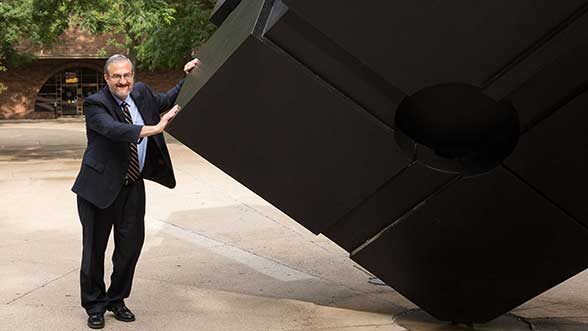
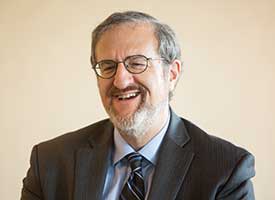
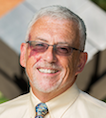

Karan Singh - PhD 1997
Welcome to Michigan President Schlissel.
We are fortunate to have you lead the greatest campus on earth!
Reply
Marie S - BA 2009
Welcome, and good luck!
Reply
Susan Leonard - MPH 2010
Welcome President Schlissel from all students and alumni.
Reply
Emily Bembeneck - PhD 2013
Welcome, President Schlissel! Very excited to see how the diversity and excellence of our great school improves under your leadership.
Reply
Bonnie Brereton - Buddhist Studies (Thailand) PhD 1992
Please do not neglect supporting Michigan’s long tradition as a bastion of Asian studies, including 4 Southeast Asian languages and the Javanese gamelan orchestra (which draws participants from the AA community as well as the university. Some of these programs are in danger of losing funding, or as in the case of the gamelan, a home on campus. I now live in Chiang Mai. Thailand, but I owe so much to the education I received at Michigan (MAs in Southeast Asian art & Asian studies). It would be a shame to lose such programs.
Reply